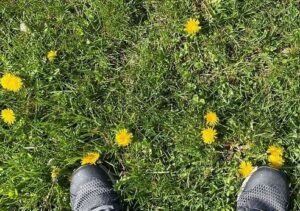Hello fellow readers, Have you ever heard of No-Mow May? It’s kind of like Dry January when folks forgo alcoholic drinks after a holiday of overindulgence. Well, maybe the only likeness is it lasts a month—the benefits of not mowing your grass in May last far longer. And it is easier than skipping wine with dinner (smile).

A No-Mow May lawn is lovely and kind.
No-Mow May Helps Pollinators
No-Mow May allows for the emergence of early bloomers to help pollinators in the early season. I first heard about it last Spring when visiting a new client who has a weekend home on Lake Mohawk. Tammy adds native plants as she develops her gardens, allowing some of her backyard to remain uncut or rarely cut after May.

Our native Common Blue Violet is essential for early pollinators (Viola sororia).
Digging further, I learned the No-Mow May movement started with Plantlife, an organization in the UK, and its catching momentum here. There’s the native Common Blue Violet (Viola sororia), also known as Woolly Blue-Violet or Wood Violet, that decorates lawns in early Spring with heart-shaped leaves and sweet-smelling purple flowers pollinators crave. I adore how they’ve made their way amongst our patio and the surrounding boulder wall. It’s a shame that some fastidious turf folks consider them a weed. It’s an essential flower for our pollinators, especially in early Spring.

Clover doesn’t need fertilization.
A Field of Dreams
Then there’s white clover (Trifolium repens), also called Dutch clover, used as a lawn alternative with many benefits. Before the 1950s, clover was considered an asset in lawns until the revolution of broadleaf weed killers that also kills clover; then, clover began to be considered a weed. Thankfully there’s a revival of using clover as a lawn alternative as folks realize chemical weed killers’ negative impact on our environment and health.
White clover mixed with grass seed in high-traffic areas like sports fields is becoming a trend. It squelches weeds and doesn’t need fertilizing. Most magnificent is clover attracts beneficial insects like our important pollinators that have been dangerously in decline — imagine a field of dreams rather than a yard of chemicals.
Dandelions get a bad rap.
Then there are dandelions that get a bad rap, though I adore how their sunny yellow flowers polka dot the yard. And all parts of the plant are edible.
 Dandelions are full of nutrition, more so than kale and spinach, and the greens taste like arugula. Plus, they attract beneficial ladybugs who feed on pests such as aphids, mites, leafhoppers, scales, and mealybugs. They aren’t bees’ favorites or best food source; they prefer the before-mentioned bloomers and spring flowering trees, but they fill in the gap. You’ll see bees flitting from bloom to bloom, especially when a lawn is plentiful with sunny dandelions like mine :^).
Dandelions are full of nutrition, more so than kale and spinach, and the greens taste like arugula. Plus, they attract beneficial ladybugs who feed on pests such as aphids, mites, leafhoppers, scales, and mealybugs. They aren’t bees’ favorites or best food source; they prefer the before-mentioned bloomers and spring flowering trees, but they fill in the gap. You’ll see bees flitting from bloom to bloom, especially when a lawn is plentiful with sunny dandelions like mine :^).
Beyond the benefits to pollinators, No-Mow May helps suppress undesirable emerging weeds and maintains moisture in the soil, as does cutting your lawn high, three inches or four, all season long.
Share the Facts
There are local ordinances to consider, especially in front yards, so check your town or homeowners association for what’s allowed and explain your intention of helping our pollinators. Maybe they’ll ease the rules. Penn State Extension Office has a helpful fact sheet titled Neighborly Natural Landscaping in Residential Areas that may help the cause (link below).
And there are ways to keep neighbors happy by cutting an edge along sidewalks and paths. Perhaps put up a sign about the benefits of No-Mow May or Low-Mow Spring. Maybe you’ll start a trend in your neighborhood. And more bees will be happy.
Garden Dilemmas? AskMaryStone@gmail.com and your favorite Podcast App.
There’s more to the story in the Garden Dilemmas Podcast:
On a related note, the issue of moss in folks’ yards always comes up in the Spring, and so I thought I’d dig up a story from long ago – To Lime or Not to Lime Lawns
Penn State Extension Office- Neighborly Natural Landscaping in Residential Areas
Related stories you’ll enjoy:


